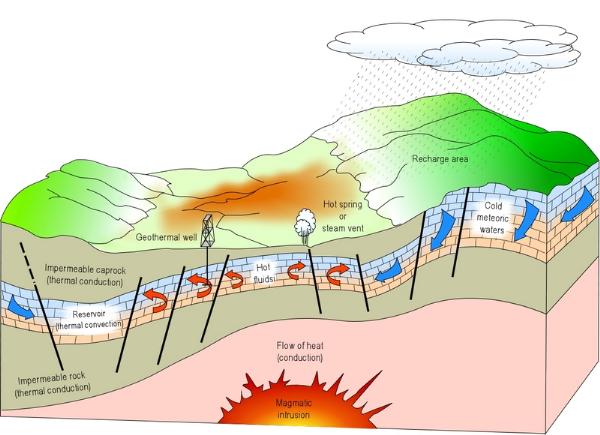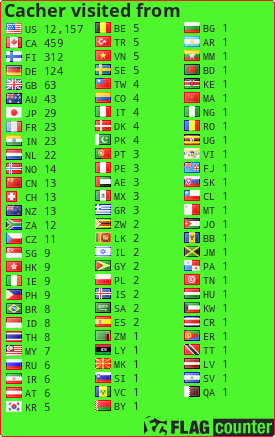Geothermal Hot Springs - McKenzie Bridge EarthCache
Geothermal Hot Springs - McKenzie Bridge
-
Difficulty:
-

-
Terrain:
-

Size:  (not chosen)
(not chosen)
Please note Use of geocaching.com services is subject to the terms and conditions
in our disclaimer.
HOT SPRINGS - a source of water flowing that emerges onto the
surface of the earth from underground that has been heated by hot
or molten rock while underground; often associated with areas of
constant, rarely violent, volcanic activity
THE GEOTHERMAL RESOURCE
Under Earth's crust, there is a layer of hot and molten rock called
magma. Heat is continually produced there, mostly from the decay of
naturally radioactive materials such as uranium and potassium. The
amount of heat within 10,000 meters (about 33,000 feet) of
Earth’s surface contains 50,000 times more energy than all
the oil and natural gas resources in the world.
The areas with the highest underground temperatures are in regions
with active or geologically young volcanoes. These "hot spots"
occur at plate boundaries or at places where the crust is thin
enough to let the heat through. The Pacific Rim, often called the
Ring of Fire for its many volcanoes, has many hot spots, including
some in Alaska, California, and Oregon. Nevada has hundreds of hot
spots, covering much of the northern part of the state.
These regions are also seismically active. Earthquakes and magma
movement break up the rock covering, allowing water to circulate.
As the water rises to the surface, natural hot springs occur, such
as Belknap Hot Springs in the Cascades. The water in these systems
can be more than 200°C (430°F).
Note that hot springs in volcanic areas are often at or near the
boiling point. People have been seriously burned and even killed by
accidentally or intentionally entering these springs. People should
always use great care and respect all signs and warnings at hot
spring sites. The hot springs in and around Belknap are quite safe
for human use.
Hot springs range in flow rate from the tiniest "seeps" to
veritable rivers of hot water. Sometimes there is enough pressure
that the water shoots upward in a geyser, or fountain. The flow
rate here at Belknap is approximately 60 GPM.

GEOLOGY OF BELKNAP
Belknap Hot Springs is located in the Willamette National
Forest, in the heart of the Cascade Range here in Oregon. The
Willamette National Forest is quite the diverse area. It ranges in
elevation from 1500 ft. to 10500 ft. The hot springs is located
closer to the lower elevation. But don't let this deceive you.
Though lower in elevation it is still very much a part of the
Cascade Range that experiences weather at all ends of the spectrum.
This diverse weather nurtures a wealth and multitude of life. The
forest area can receive 80 to 150" inches of precipitation a year.
Most of this is in the form of snow in the higher elevations that
melts throughout the warmer months and feeds into many creeks,
streams and rivers. One of the most predominant features you'll
find here are the trees, specifically Douglas Fir, though you will
find many other varieties, such as, Pine, Cedar and Hemlock. Once
you get beneath the canopy of the dense and lush forest of the
Willamette, you begin to hear the sounds of life! That life is the
snow melt coming down the mountains into rivers such as the
Willamette, Santiam and the one of our focus the McKenzie! The
McKenzie's headwaters rises up into the Three Sister's area in the
East and comes cascading through the lava flows, in some areas
forming majestic waterfalls, down through McKenzie Bridge, then
later at Blue River where it meets up with the South Fork.
Eventually down in the valley the McKenzie meets up the Willamette
River. But we want to go back up to the McKenzie Bridge area. The
life water helps support not only the growing life of the forests
but some of Oregon's most prideful animal life. You may find the
Spotted Owl, Bald Eagle, Chinook Salmon, Bull Trout, deer, elk and
even a bear! Even though the forests are the obvious feature you'll
see, water is pretty substantial as well. There are over 1500 miles
of rivers and streams in the WNF as well as 375 lakes. The complete
beauty of the area can lure people away from the mystique and true
history to the area. These mountains are volcanic in nature and
most of the surrounding area you will see was formed or created by
volcanic activity. The Cascade Range is part of a chain of mountain
ranges called the Ring of Fire. The Three Sister's are the most
predominant of the nearby volcanoes. Though these three mountains
and others nearby lie mostly dormant or asleep, they may be showing
signs of life. In 2001, satellite photos showed an area just south
of the sisters experiencing what they call an uplift. The magma
that lies deep below the earths surface has been pushing towards
the surface and causing swarms of earthquakes in the area. Recently
the uplift has slowed but there is still thought that the area is
slowly coming back to life or awakening. It's this magma deep below
the earth's surface that is the culprit in bringing us this flow of
hot water from inside the earth. Water seeps into the earth finds
the gaps between rocks and flows into areas where volcanic or
superheated rock and magma are. The water boils and under pressure
from the heat is pushed back to the surface where it finds an
opening in the earth's crust and we have a hot spring! The flow can
be as little as trickle or as much as a gushing river out of the
earth.
At Belknap Hot Springs there is a rocky outcropping out of the
side of a hill along the McKenzie River. This is where, under
pressure, water has forced it's way to the surface and continues to
run out the side of the hill and into the McKenzie River. There are
multiple places up and down the river where you will find these hot
springs emerging from the earth. At this spot enterprising
individuals have captured the hot springs for the enjoyment of
many. In other areas you can come upon a spot where you will see
the steam rising as hot water reaches the surface and mixes with
the icy cold waters of the McKenzie. The water in this area when it
reaches the surface is still very hot! It can cause bodily injury
if not respected. So always treat hot springs in nature with the
upmost respect! But certainly enjoy them as much as you possibly
can too!
BELKNAP HISTORY - The first record of exploration and discovery
of the springs occurred in 1854 by a group of men known as the
"McBride Party". The group included George Millican, John T. Craig,
James Storment, and Joseph Carter, all of whom settled in the
McKenzie River Valley. It was 15 years later in 1869 when Rollin
Simeon Belknap discovered the hot springs and took claim in 1870
with plans to make a health resort and mineral spa. Originally from
Middlesex, Vermont, R. S. Belknap set off from Boston,
Massachusetts to explore and look for gold in the Northwest
Territory. He ended up in San Francisco in 1849 and later in
Southern Oregon, where he fought in the Rogue River Indian War in
1855-1856. In the 1870's, R. S. Belknap brought his family to the
hot springs and began development of a mineral spa
resort.
THERAPEUTIC RESOURCE - Because heated water can hold more
dissolved solids, warm and especially hot springs also often have a
very high mineral content. Because of both the folklore and the
claimed medical value some of these springs have, they are often
popular tourist destinations, and locations for rehabilitation
clinics for those with disabilities.
To get credit
for the cache you must email me answers to the following
questions:
1. What is the approximate temperature of the water at the
source?
2. How do they bring the water from the source to the pools at the
lodge? Especially with the river barrier, there appears to be
nothing visible?
3. What is the temperature they try and maintain at the pool next
to the lodge?
4. What process do they use to bring the water temp down for human
use?
5. Name at least 2 minerals that can be found in the hot spring
water.
6. Then you must take a picture of yourself and GPSr at the source
to post with your log. (optional)
Any answers posted in your log will result in your log being
deleted.
Though this area is open to the public, I have received permission
by the owners to place earthcache here. Please be respectful of
others when visiting location and leave no trace behind. They
prefer that you visit between the hours of 8AM to 9PM. Answers to
questions may require a little detective work and exploring of
site.

Additional Hints
(No hints available.)